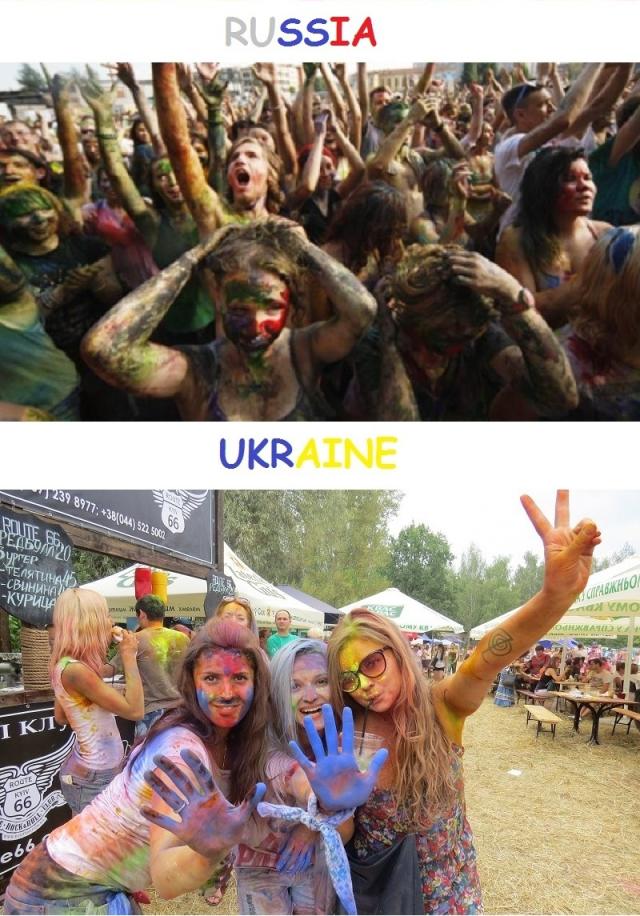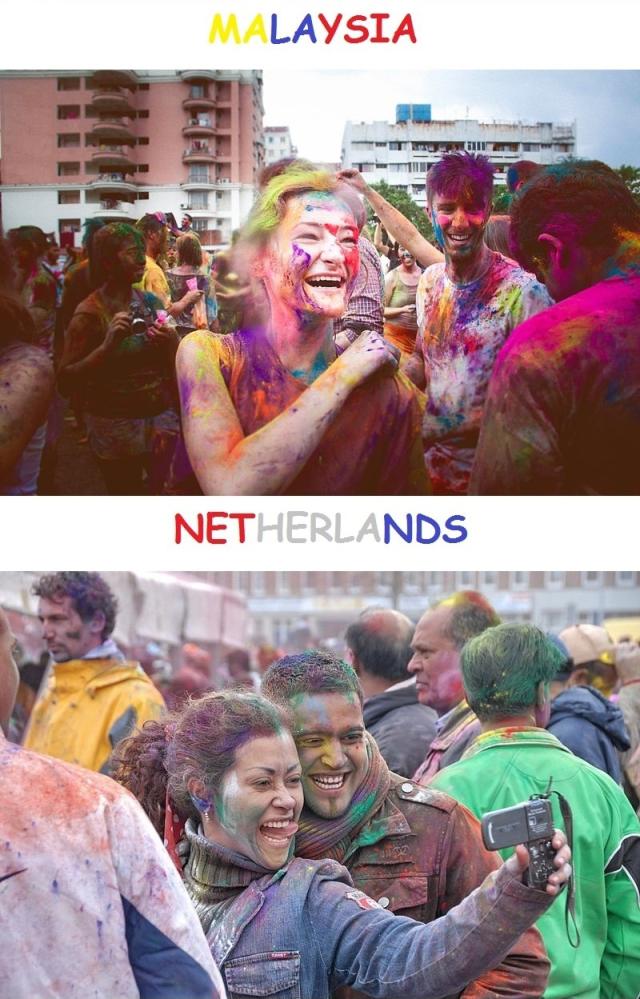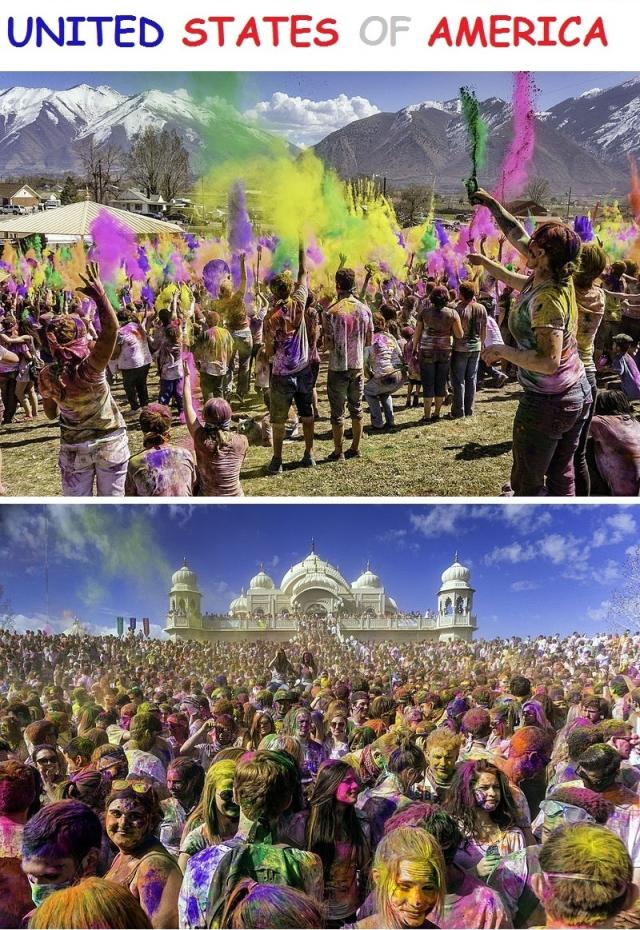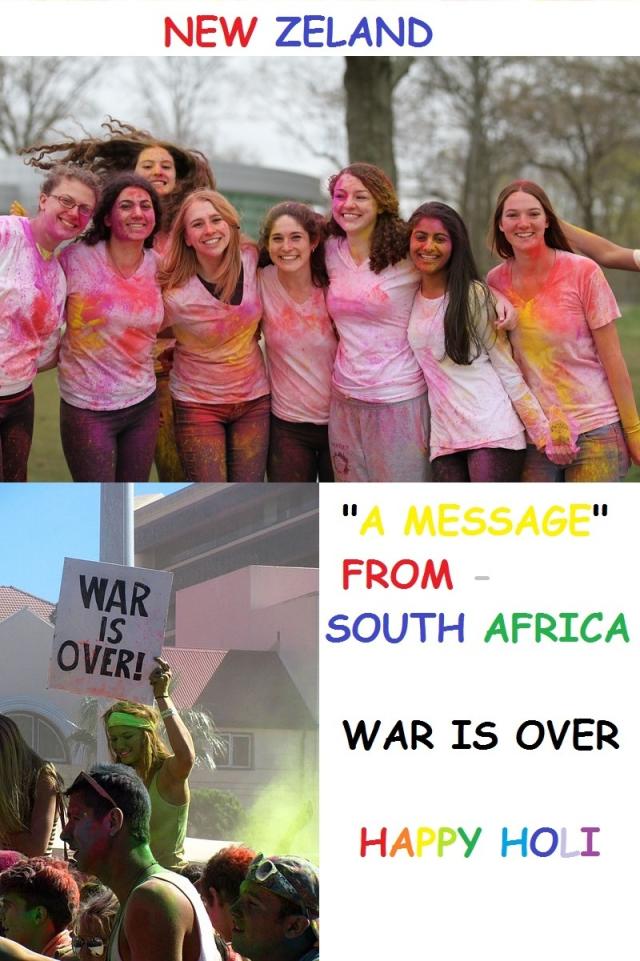My take on the festival of colours - HOLI
It is an ancient Hindu religious festival which is also known as the spring festival or the festival of love. It is primarily observed in India, Nepal, and other regions of the world with significant populations of Hindus or people of Indian origin. The festival has, in recent times, spread to parts of Europe and North America as a spring celebration of love, frolic, and colours. Holi is celebrated at the approach of vernal equinox, on the Phalguna Purnima (Full Moon). The festival date varies every year, per the Hindu calendar, and typically comes in March, sometimes February in the Gregorian Calendar. This year it will be celebrated on Friday , March 6 2015. [2016 date Wednesday, March 23; 2017 date Monday, March 13].
Significance
There are so many reasons about why it is celebrated. So, in order to keep this article short, I'll mention the primary reason only. The festival gets its name from the Puranic (ancient) story of Holika. Holika was the sister the demon-king Hiranyakashipu. The king, egoistic as he was, desired that everybody in his kingdom worship him alone because he had earned a boon that made him virtually indestructible. Much to his ire, he found that his son, Prahlada, disagreed with him and remained a worshipper of Lord Vishnu. It was then that Hiranyakashipu decided to kill Prahlada in connivance with his sister. Holika had been granted a boon that gave her the power to remain unaffected by fire by wearing a cloak. To lure Prahlada into a fire, Holika sat him on her lap and pretended to play with him while Hiranyakashipu ordered his men to set the place where they sat on fire. As the fire roared, the cloak flew from Holika and encased Prahlada. Holika burned, Prahlada survived. Vishnu appeared and killed Hiranyakashipu. The bonfire is a reminder of the symbolic victory of good over evil, of Prahlada over Hiranyakashipu, of fire that burned Holika. The day after Holika bonfire is celebrated as Holi. Holi symbolises victory of our higher aspirations over our lower, base desires. It is the burning of our petty, material desires at the altar of our goal of self-development. It stands for the victory of good over evil, a theme that runs through every Indian festival. For it is impossible that those who live their lives by truth will ever be overcome by the corrupt.

Holika bonfire
Celebrations
- Main
Like the picture above, on the eve of Holi, typically at or after sunset, the pyre is lit, signifying Holika bonafire. People use to decide the suitable location and start collecting woods days before the occasion. After the ignition, people use to clap, sing and dance around the pyre. It is something like a role-playing the event. Literally, this is the way to celebrate the festival but actually, Holi is not known by this celebration. The following day is called as Dhulendi (also Dhulandi or Dhulheti) and this is the real celebration day. The celebrations start immediately. People come out of their house armed, activate their animal-mode and become frolic. Their ammunition contains water-gun, water-baloons, colour sprays, Gulal (dry colour) and Rang (wet colour). People are allowed to colour any person they want even if he/she is a random stranger or even enemy. Yes, this is the best part that all the offences and anger gets dissolved with one boisterous shout of 'Bura na mano, holi hai!' (Don't be angry, it’s Holi!). You can colour and deluge anyone and use this dialogue. It is a festival to shake off the shackles of what is to be done and what is not to be done for once and loosen up a bit. It is a festival to let your hair down and do what you like, say what you like and meet and tease anybody you like. To add some flavour, people make a drink of Hemp. For some people, holi is tasteless without cannabis. So basically, to celebrate holi all you need is colour, water, enthusiasm and a horde of victims.

- Regional
India being a big country, some traditions vary depending upon the region.
North India: Lord Krishna spent most of his childhood in this region. He was very naughty and use to tease women by teasing them and stealing milk, butter and curd from the cow maids' houses. So it is celebrated by the playful teasing of women and attempts to color them with 'gulal' and wet colors from 'pichkari' is returned by them by attempts to escape and beating the men with sticks to scamper them away.
Haryana (my state, N-Zone): The brides of the Hindu undivided families hang a pot of buttermilk high up in the streets as a challenge to their brother-in-laws, who try to get ot break the pot by forming a human pyramid to reach it. Women try to stop them by beating them with their saris rolled up as ropes. This mock-drama is staged to commemorate the playful pranks of child Krishna. In the evening, the brother-in-laws bring sweetmeats for the women of the house for their contribution in keeping the family united.
Western India: [same as N-Zone with less beating part]
Eastern India: Women perform devotional songs and dances around the swing as men spray coloured water and 'Abeer' (coloured powder) on them. However, the tradition is being lost in the modern wave and people play with coloured water and powders in the morning and then take out processions on the streets with music and drums while stained with Holi colors.
North East: Holi is celebrated here for six days non-stop! In earlier times, there were folk songs and dance performances under the moonlight accompanied by the indigenous drums. Today, modern musical instruments have replaced the drums and fluorescent lamps have replaced the moonlight. Days before, people collect money from the community for the expenses on the festivities. A thatched hut of hay, twigs and sticks is built, only to be set ablaze. Next morning, groups of boys go to play 'gulal' with the girls and pay them money to get the favor. Devotees play, sing and worship in the Krishna temple.

- The after party
After a day of play with colours, people clean up, wash and bathe, sober and dress up in the evening and greet friends and relatives by visiting them and exchange sweets. Holi is also a festival of forgiveness and new starts, which ritually aims to generate harmony in the society.
The bright side :-
- It is the time when winter ends and spring arrives. Farms and gardens flourish making the atmosphere pleasant and like a paradise.
- On this occasion, family and friends get-together and celebrate with each other.
- Not just relatives but strangers and even enemies become your friends leaving a great message of humanity and peace.
- Traditionally, washable natural plant-derived colours such as turmeric, neem, dhak, kumkum were used which helps in fighting the micro-organisms which are very active during the period of season changing.
- The whole concept is based upon the victory of good over evil. Righteousness!
The dark side :-
- Because of touching each other while colouring, changing of the season and using of cold water, people are prone to many communicable and non-communicable diseases.
- Youth groups like to detach the silencer of their bike and race with each other mischievously on that occasion. It increases the noise pollution and their bikes can skid because of wet streets.
- People consume drugs and gamble a lot on that day.
- Women become insecure and a lot of girls get raped as there is so much noise and the accuser can hide their face behind the colours.
- Some traditions are very bad (especially in N-Zone) because it is violent called as Lathmaar Holi (HitStick Holi)

- The colours are no longer natural, they are synthetic. Toxic water-based commercial pigments containing lead oxide, dermatitis, aluminium bromide, with mercury sulphide are increasingly used nowadays which is bad for skin.
- An estimated total of 3000000 Kg of wood burnt every year during holika bonfire and a lot of water is being polluted during celebration.
- Some people think that it is offensive to attend Holi parties if you’re not a Hindu or Indian.
Well, the last point maybe legit for most readers, but I must inform you that it is not true. Holi can certainly be celebrated by non-Hindus. There is no discrimination, and the message is universal. Let me show you =>
Celebrations in other cultures







[credits] wikipedia.org (for some content); wikimedia.org (for images)
For some deep reading, I suggest you to read it.
Thank you for reading :-)
If you liked it then thanks you very much :D
If you disliked it then 'Bura na mano, holi hai!' (Don't be angry, it’s Holi!). :P

Game on folks, Believe!
Most Helpful Opinions